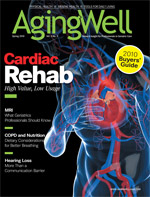Spring 2010 Nutrition Following Heart Attack Heart disease is the leading cause of death in those aged 65 and older. This translates into an estimated 38 million Americans diagnosed with some type of cardiovascular disease, according to the American Heart Association (AHA). Of these, approximately 8.5 million will suffer a heart attack. The average annual rate of a first heart attack rises from three per 1,000 for 35- to 44-year-olds to 74 per 1,000 for those aged 84 to 95. Among Americans of all ages, it’s estimated that in 2010, some 785,000 will suffer a first heart attack and approximately 470,000 will have a recurrent attack, according to the AHA. Diet’s Role The two blood fats that make up cholesterol can be potent indicators of heart attack risk and reoccurrence. For example, a study of 89 patients with a mean age of 67.3 who had suffered one heart attack showed a greater risk for a second heart attack within one year of the first attack when they had lower HDL (good) cholesterol and smoked.1 Recommend that your patients review the AHA’s tips for lowering cholesterol such as avoiding foods high in cholesterol and saturated fat (eg, fatty red meats, dark-meat poultry with the skin, full-fat dairy products) and foods that contain trans fats (eg, fried foods, baked goods, stick margarines). Fruits and vegetables, whole grains, nuts, and avocados contain no cholesterol, and lean red meats, poultry, and fish, as well as nonfat milk and dairy products, contain low amounts of cholesterol. Eating certain high-fiber foods can reduce serum cholesterol. For example, cereal grains such as oats and barley, as well as a variety of mushrooms, contain polysaccharides called beta-glucans. Some ways beta-glucans can reduce serum cholesterol include by reducing the intestinal absorption of cholesterol, shifting the liver from cholesterol synthesis to bile acid production, and fermentation by intestinal bacteria to short-chain fatty acids where they are absorbed and then prevent the synthesis of cholesterol in the liver.2 Your patients can also add soybeans to their diets. A study conducted in Mexico on 43 people with hyperlipidemia revealed that after three months following a low saturated fat diet supplemented with 25 g of soy protein and 15 g of soluble fiber, they experienced a 20.6% drop in serum cholesterol and a 40.4% drop in serum triglycerides.3 Soybeans aren’t the only beans that can be beneficial. Last year researchers at Tulane University analyzed 10 randomized clinical trials representing 268 participants and found that subjects treated with a legume diet, or a diet containing dried cooked beans and peas, compared with controls experienced an average decrease in total serum cholesterol of 11.8 mg/dL.4 Dried peas and beans include black beans, black-eyed peas, chickpeas, kidney beans, lentils, lima beans, navy beans, and pinto beans. Older adults often need more protein in their diets, especially following a heart attack since decreased appetite and/or a disruption in normal eating habits may have increased the risk for malnutrition. Joan Salge Blake, MS, RD, LDN, an ADA spokesperson and clinical associate professor at Boston University, says, “Dried beans and peas can supply this protein without the cholesterol and saturated fat found in animal proteins. Beans are cholesterol free and fat free and can lower serum cholesterol by virtue of their fiber content. It’s a wonderful swap.” Blood Pressure and Dietary Sodium According to research published in the January issue of The New England Journal of Medicine, reducing dietary salt by 3 g (1,200 mg of sodium) per day is projected to reduce the annual number of new cases of cardiovascular disease by 60,000 to 120,000 and heart attacks by 54,000 to 99,000. The researchers concluded that older adults would benefit most from this recommendation in terms of cardiovascular disease. The 2005 Dietary Guidelines for Americans recommends consuming less than 2,300 mg (approximately 1 tsp) of sodium per day. Yet the average American consumes nearly 4,000 mg per day. The best way to reduce sodium intake is using fresh herbs and spices rather than salt in cooking and avoiding canned and processed foods as much as possible. Body Weight One way your patients can reach a healthy weight, especially those who have already suffered a heart attack, is to eat more low-calorie, nutrient-rich foods such as fruits and vegetables, whole grains, low-fat or nonfat dairy products, and lean protein foods. Putting It All Together — Carol M. Bareuther, RD, is a St. Thomas, U.S. Virgin Islands-based writer who contributes to a variety of regional, national, and international publications.
References 2. Rondanelli M, Opizzi A, Monteferrario F. [The biological activity of beta-glucans.] Minerva Med. 2009;100(3):237-245. 3. Torres N, Guevara-Cruz M, Granados J, et al. Reduction of serum lipids by soy protein and soluble fiber is not associated with the ABCG5/G8, apolipoprotein E, and apolipoprotein A1 polymorphisms in a group of hyperlipidemic Mexican subjects. Nutr Res. 2009;29(10):728-735. 4. Bazzano LA, Thompson AM, Tees MT, Nguyen CH, Winham DM. Non-soy legume consumption lowers cholesterol levels: A meta-analysis of randomized controlled trials. Nutr Metab Cardiovasc Dis. 2009 Nov 23;Epub ahead of print. 5. Cruzen C, Colman RJ. Effects of caloric restriction on cardiovascular aging in non-human primates and humans. Clin Geriatr Med. 2009;25(4):733-743. 6. Oliveira A, Rodriquez-Artalejo F, Severo M, Lopes C. Indices of central and peripheral body fat: Association with non-fatal acute myocardial infarction. Int J Obes (Lond). 2010 Jan 12;Epub ahead of print. |

